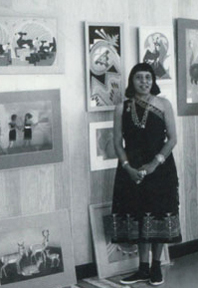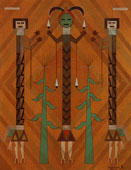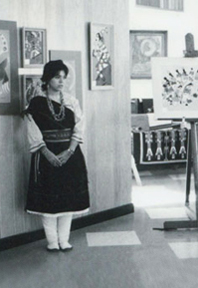Untitled Painting Seated Female with Baskets by Diane O'Leary - C3755A
Diane O'Leary (1935 - 2013) Opeche-Nah-Se developed into an amazing artist. She was an academic wonder-achieving a BA, BS and MS from Texas Christian University, an MS from Harvard and an MA, MFA, & PhD from Stanford. Somewhere along the way she had attended Bacone College too. She had planned a career in physics but instead dedicated her life to art and as an activist for the dignity and equality of women.
O'Leary's father was Irish and her mother a member of the Comanche Tribe. She moved to Taos, New Mexico, in 1967 at a time when interest in American Indian art was beginning to blossom. She studied under painters Eric Gibberd and Emil Bisttram at Taos. She knew Georgia O'Keefe and received occasional criticisms from the artist.
Historic Acoma Polychrome Geometric Design Water Jar - C3758C
There has always been some question as to when potters started signing their name to pottery. For decades, there was nothing to indicate potter or pueblo on earlier pieces. Later, potters at Acoma started adding some form of Acoma, New Mexico to their work, then Acoma Sky City, then eventually a potter's name.
The earliest "signature" could be considered the design used on pottery. Families had designs that they preferred and that became known as the "signature" of that family. One could look at a design and feel confident that a potter of a certain family made that item.
Historic Acoma Pueblo Large Water Jar - C3758B
With the arrival of the transcontinental rail line passing through New Mexico, potters at Acoma Pueblo realized a market for pottery that would generate cash for their work. The train stopped at Laguna Pueblo and Acoma potters would take their wares and join the Laguna potters in selling to the train passengers. That is one reason there is confusion concerning whether a jar was from Acoma or Laguna. Little documentation was gathered in the frantic hurry to make a purchase before the train had to continue on its way. A buyer might have made a note that the jar was purchased at Laguna Pueblo, but failed to note whether it was from an Acoma or Laguna potter, a fact of which the buyer may not have even been aware.
Do you want to know more?
Kewa Pueblo (Santo Domingo) Chile Bowl with Sunburst Design - C3753.60
Chile bowls have their start in life as any other pottery bowl-that is they have a clay bottom formed in a puki and side walls that grow upward one coil at a time. Their walls are scraped and sanded and eventually painted with a design of the choice of the potter or a design fostered by tradition. The best view of a bowl is from the side at a slight angle so one can appreciate the decorated exterior and have a glimpse of the interior below the rim.
Would you like to know more?
Kewa (Santo Domingo) Chile Bowl with Infinity Design - C3753.61
This is a traditional Kewa Pueblo chile bowl that shows evidence of use in the past. The interior is slipped in white clay as is the exterior. The exterior design panel is a continuous line of black designs arranged in the infinity pattern with each section containing a series of black dots. The design is intriguing but was laid on in a rather loose style with some smearing of the black paint.
Would you like to know more?
Kewa (Santo Domingo) Pueblo Large Chile Serving Bowl - C3753.13
This bowl is a little larger than most chile bowls and a little smaller than normal serving bowls, so it falls between the two. The interior and exterior are slipped in traditional Kewa Pueblo cream slip with the lower portion of the exterior being in red slip. The black triangular designs are laid in sections of four, back-to-back and top-to-bottom.
Would you like to know more?
Zia Pueblo Small Serving Bowl - C3753.28
This small Zia serving bowl is about as perfect as it could possibly be. It is beautifully symmetrical, sits straight, has a beautiful dark brick red slip on the interior, black rim and a white band on which a brown design of traditional Zia style is painted. Below the design panel is a stone-polished red underbody with a wiped-on red band separating the design area and the underbody. The use of a wiped-on red band supposedly ended around the 1930s but it is not likely that this bowl dates to that early period. It appears to be closer to mid-20th century.
German Silver Discs on Leather Belt - C2942V
German silver, which is an alloy that contains no silver, was a favored metal of the Plains Indian tribes. The rings, bracelets and hair plates, which in turn became belt conchas, worn by the Kiowa, Comanche, Dakota, Cheyenne, Ute, Pawnee, Osage, etc., were of this thin metal. These silver discs were strung and worn by the Plains tribes as hair pieces, that is, they were tied to the hair and draped down the back of the head. Sometimes the sizes of the discs were graduated and other times they were the same. They also wore them draped down their side from the waist.
Would you like to know more?
Original Painting of a San Ildefonso Black-on-black Plate by Tony Da - C3512.01
This painting was completed in 1981, the year before Tony sustained severe head injuries in a motorcycle accident that left him with a twenty-five-year memory loss, a partial disability, and a mental age of about seventeen, at a time when he was biologically forty-one years of age. It could possibly be one of the last painting he made before the accident.
Tony Da is known for his amazing pottery creations but he first started his career as a painting artist. He once said that paintings were his first love and pottery was a short part of his career. After partially recovering from his motorcycle accident, Tony completed a few more paintings but never made any more pottery.
Sterling Silver Navajo Guild Concha Belt - C2942U
The United States Congress, at the urging of the Indian Service, created the Indian Arts and Crafts Board on August 27, 1935. In general, its function was "to promote the economic welfare of the Indian tribes through the development of their handiwork or manufactures." The IACB, in turn, created the Navajo Arts and Crafts Guild (NACG) in September 1941. The guilds were established to provide the artisans a place to sell their wares. Each guild aimed its products at "quality stores in the East, Mid-west, and Southwest," and avoided the tourist market. A minimum-wage scale was established for graduates of the guild.
Would you like to know more?
Tradition & Innovation: the art of Pablita Velarde and Helen Hardin
|
Adobe Gallery is proud to present this exhibit showcasing original paintings from two remarkable artists. Pablita Velarde (1918-2006) Tse Tsan - Golden Dawn and her daughter, Helen Hardin (1943-1984) Tsa-Sah-Wee-Eh - Little Standing Spruce. Although these two artists certainly had their differences, there is no denying that they share more than a few similarities. Not only in their artistic style, in which considerable comparisons are available, but also in their undying spirit and verve. They each had an ability to draw on the traditions and imagery of their culture while creating a unique and innovative style that makes each of them instantly recognizable. On display will be original works from both artists as well as books on each of them.
|
||
 |
Pablita Velarde worked for years in the studio she built herself and primarily worked with pigments she made herself. Her mesmerizing art simultaneously honors a faithfulness to her people and culture while showcasing her own unique style. |  |
|
|
The art of Helen Hardin expresses the dichotomy of her Indian and non-Indian upbringing. She manages to capture her native heritage while departing from the Studio style of her predecessors, including her mother, Pablita. |  |
|
The varied pieces of art in this collection match the wide range of styles that these two artists employed during their careers. From representational style paintings that depict Pueblo and employ traditional media like mineral earth and casein, to abstractions executed in acrylic with highly detailed backgrounds, this show should not be missed.
|
||
Hopi Pueblo Wakas - Cow Katsina Doll - 25851
The Wakas'katsina is the Cow Katsina. He seems to have first appeared in the Hopi pantheon of Katsinas around 1900 and has appeared regularly since then. He represents an animal spirit messenger to the Rain gods. The songs and dance movements are prayers for rain, and are symbolic of animals' self-sacrifice in supplying food to sustain life. - Secakuku
Would you like to know more?
Miniature Acoma Polychrome Water Jar by Delores Juanico - 25850
Delores Juanico is a daughter of Marie S. Juanico (1937 - ) who was her mentor. Marie had learned pottery principals from her mother, Delores Sanchez, who lived to the age of 103. Young Delores carries on the tradition from her grandmother and mother of making the finest Acoma pottery.
Read more about this pottery here.
Zuni Pueblo Silver and Turquoise Band-style Ring - C3737V
Zuni jewelers are trained lapidary artisans who excel in cutting and setting small stones, sometimes in a mosaic pattern and other times in channel inlay form. This sterling silver ring has turquoise stones set in channel inlay in stone-to-stone fashion. The edges of the silver ring are stamped with feather-like designs. The ring dates to circa 1980s and the turquoise has darkened to a rich patina from age.
Read more about this ring here.
A Pair of Eagles Perched on a Rock Cliff by Beatien Yazz - C3665B
When a youngster grows up on the Navajo Reservation, as did Beatien Yazz, everything he sees and learns reinforces his beliefs in the natural world. The Navajo believe one is in harmony with nature when one is well, and is no longer in harmony with nature when sick. There is a strong belief in how important nature is in its effect on the individual. It is no wonder, then, that so many Native painters focus their art on nature, landscapes, horses, clouds and rain, and the abundance of animals and birds.
Read more about this painting here.
Oil Painting of Navajo and Horse Startled by Storm by Beatien Yazz - C3667C
Most of the Beatien Yazz paintings we have had in the past have been of acrylic or casein paints but he is acknowledged as having painted in oil paints. This painting appears to be oil on canvas board, the first one I recall seeing. He is also known to have painted murals at the Navajo Tribal Court Room in the Navajo Police Headquarters, Fort Defiance, AZ. He is credited with pottery designs, tile designs, prints, fabric designs and designs for greeting cards. We tend to think of him just producing paintings but he was much more involved in art than that. He was a very talented man who had a long career from just a young boy to an octogenarian.
Read more about this painting here.
Hopi Third Mesa Wicker Pictorial Plaque - 25738
Third Mesa wicker plaques, or yungyapy, as they are called at Hopi are the most common form of basketry at Third Mesa. Although a large number are made for sale, even a larger number never leave the reservation. They are used in payment for the Hopi bride's wedding robes, used as gifts to repay favors or for work performed, or as prizes in footraces. They are also used as part of the dance paraphernalia in women's dances and as gifts to newborn babies.
Read more about this Hopi Pueblo basket here.
Zia Pueblo Polychrome Olla With Trios Design - 22969
Typology designations of pueblo pottery have been assigned by noted authorities based on observed changes over decades. At Zia Pueblo, one of the earlier designations is Puname Polychrome (1700-1760) which was followed by the designation San Pablo Polychrome (1760-1820), then Trios Polychrome (1820-1860) and, finally, today's designation of Zia Polychrome (1860-present).
Although designations have been assigned to periods of production as shown above, it must be remembered that potters actively working at the time did not necessarily make changes simultaneously. A potter making pottery in 1855, during what has been designated as the Trios Polychrome period, might have continued her style until her death maybe in 1895. Technically, according to the authorities, she was in the Zia Polychrome period, although she, herself, was still making what she had learned to make in the Trios Polychrome designated period. The designation was not observed by potters, only by authorities studying pottery.
Read more about this pottery here.
Black-on-black Tall Neck Jar signed Marie and Julian - C3661E
Pueblo pottery was very popular in Santa Fe, New Mexico homes as decorative objects in the 1930s and later and many local residents purchased sugar and creamer sets, candlesticks, bookends and lamp bases. Some potters made tall jars suitable for lamps and some actually made them with drill holes in the bottom through which the electric cord was threaded.
This jar is the shape suitable for a boudoir lamp and it does have a drill hole in the base. The hole has been filled in and is not visible from the underside but is visible from the inside of the jar. Since the drill hole went through the "&" element, it is obvious that it was drilled after purchase and not drilled by Maria Martinez at the time it was made.
Read more about this jar here.
Black-on-black Jar with Curvilinear Designs signed Marie & Julian - C3661D
Maria Martinez is known to have had help from her sisters when making pottery. It is generally agreed that her youngest sister, Clara, polished many, if not most, of Maria's pottery for her. Desideria also helped Maria in various ways, and the male members helped gather and work the clay and prepare the outdoor firing kiln.
Read more about this jar here.


